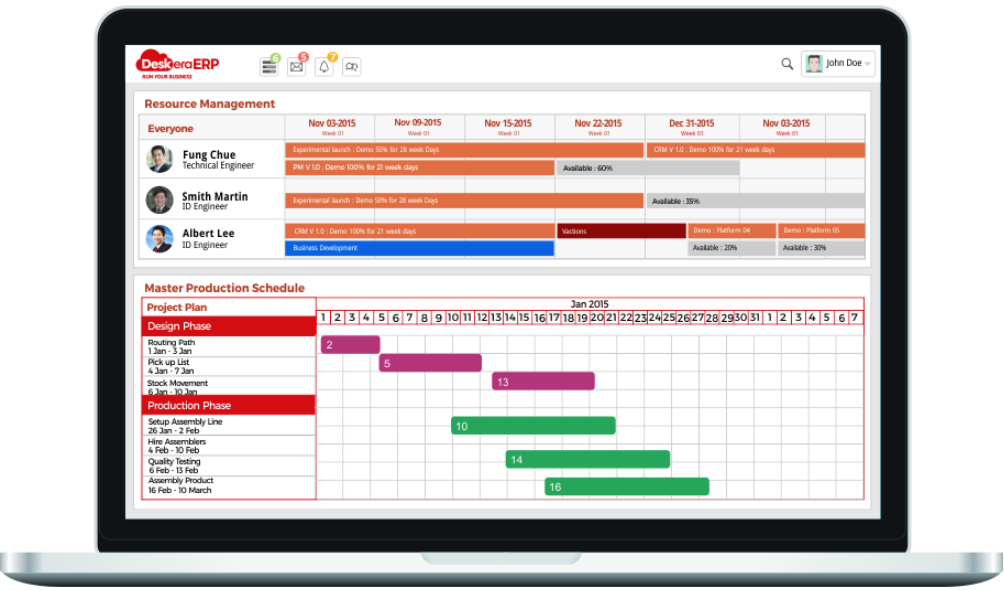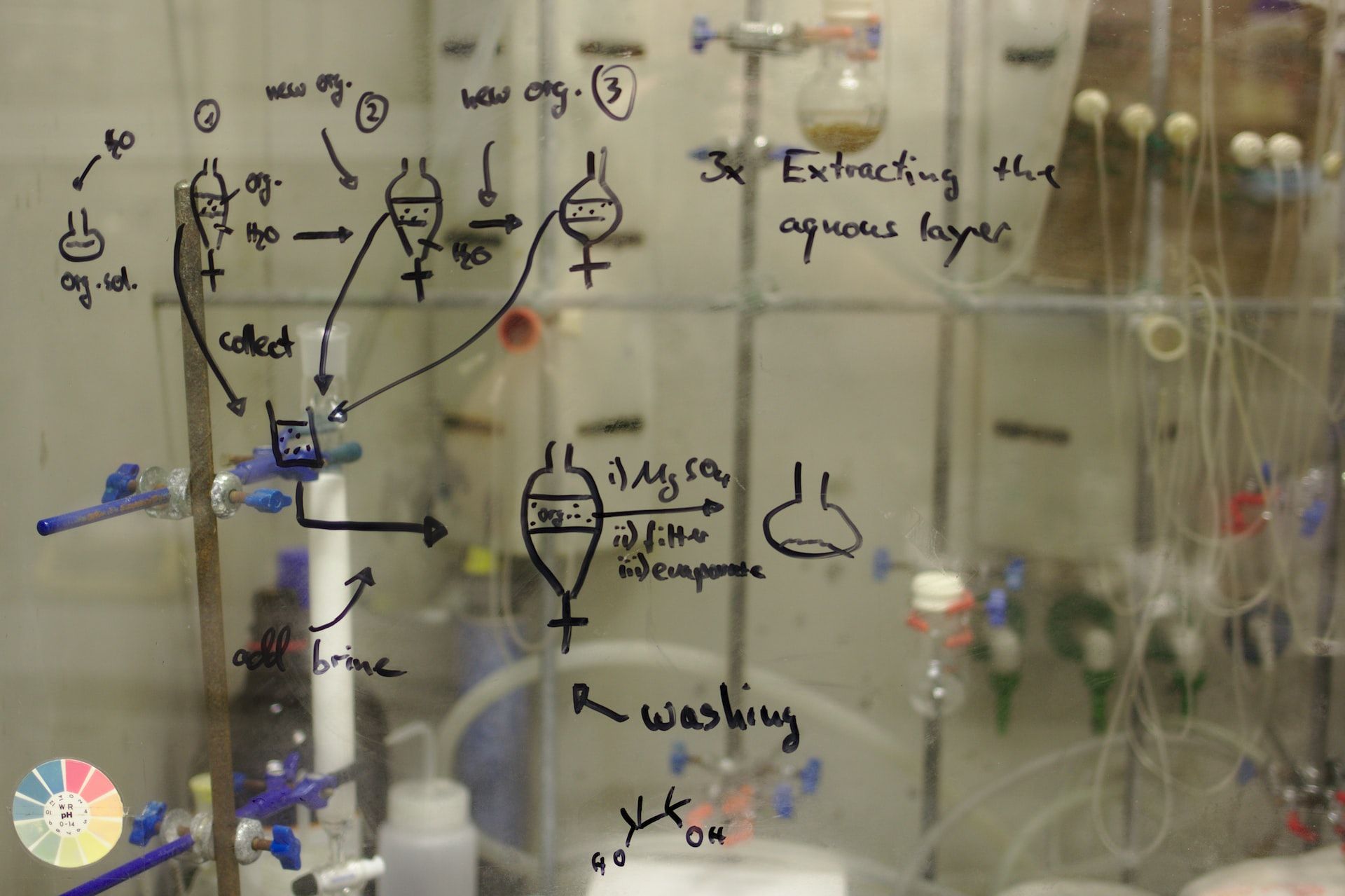From tiny insects to big rodents, pests have been a nuisance to human society for centuries. In recent years, pest control manufacturers have been developing new and innovative ways to tackle these unwanted visitors.
From eco-friendly products to advanced technology, the latest trends in pest control manufacturing are changing the game. As society continues to prioritize sustainability and integrated pest management, manufacturers are rising to the challenge and developing cutting-edge solutions.

Let's take a closer look at the latest trends in pest control manufacturing and how they're transforming the industry
- Importance of Pest Control in Modern Society
- Latest Trends in Pest Control Manufacturing
- How does MRP play an Important Role in Pest Control Manufacturing?
- How can Deskera Help You?
- Key Takeaways
- Related Articles
Importance of Pest Control in Modern Society
Pest control plays a crucial role in modern society for several reasons. First and foremost, pests can pose a significant threat to human health and safety. Many pests, such as rodents, cockroaches, and mosquitoes, can spread diseases and infections to humans.
For example, mosquitoes can transmit illnesses such as malaria, dengue fever, and the Zika virus. Rodents can carry diseases like Hantavirus and Salmonella, while cockroaches can cause allergies and asthma in humans.
Secondly, pests can cause damage to homes, buildings, and other structures. Termites, for instance, can cause extensive damage to wooden structures, while rodents can chew through electrical wires and cause fires. Bed bugs and other pests can also cause damage to furniture, clothing, and other personal belongings.
Lastly, pests can have a negative impact on businesses, including those in the food industry. Pests like rodents and cockroaches can contaminate food products and cause health hazards for consumers, resulting in costly recalls and loss of business.
Therefore, pest control is essential to mitigate the risks and damage caused by pests in modern society. Effective pest control measures can prevent the spread of diseases, minimize property damage, and maintain a safe and healthy environment for both humans and animals. By implementing proper pest control practices, we can protect our health, property, and the environment.
Latest Trends in Pest Control Manufacturing
Pest control is an essential industry that plays a critical role in maintaining public health and safety. As pests continue to evolve and adapt to new environments, pest control manufacturers must keep up with the latest trends to provide effective and efficient solutions to their customers. Here are some of the latest trends in pest control manufacturing:
- Sustainability and Environmental Friendliness
- Advanced Technology
- Integrated Pest Management (IPM)
- Customization or Pest Control for Specific Needs
- Impact of COVID-19
Sustainable and Environmentally-Friendly Pest Control Products
Sustainable and environmentally-friendly pest control products are becoming increasingly popular in modern society due to growing concerns about the environmental impact of traditional pest control methods.
These products are designed to control pests while minimizing harm to the environment and non-targeted species. Here are some examples of sustainable and environmentally-friendly pest control products:
- Biological Pest Control: Biological pest control is a sustainable and eco-friendly approach to pest control. It involves using natural predators, parasites, and pathogens to control pest populations. For example, ladybugs and lacewings can be used to control aphids, while nematodes can be used to control flea larvae.
- Botanical Pest Control: Botanical pest control involves using plant extracts and oils to repel or kill pests. These products are typically derived from natural sources and are safer for the environment than chemical pesticides. Examples of botanical pest control products include neem oil, garlic spray, and pyrethrin.
- Pheromone Traps: Pheromone traps are an environmentally-friendly and non-toxic alternative to traditional insecticides. These traps use sex pheromones to attract and trap pests, such as moths and fruit flies, without harming other non-targeted species.
- Electronic Pest Control: Electronic pest control devices use sound waves or electromagnetic waves to repel pests. These devices are non-toxic and do not harm the environment. However, their effectiveness is debated and may vary depending on the type of pest.
- Integrated Pest Management (IPM): IPM is an eco-friendly approach to pest control that involves using a combination of strategies, such as biological control, sanitation, and cultural practices, to manage pest populations. This approach aims to reduce the use of chemical pesticides and minimize harm to the environment and non-targeted species.
Advanced Technology in Pest Control Products
Advanced technology is revolutionizing the pest control industry, making pest control more effective and efficient than ever before. Here are some examples of advanced technology in pest control products:
- Automated Pest Control Systems: Automated pest control systems use sensors and monitors to detect and control pests in real-time. These systems can be programmed to dispense the appropriate amount of pesticides at the right time, reducing waste and minimizing exposure to humans and non-targeted species.
- Insect Detection and Identification Systems: Insect detection and identification systems use advanced technology, such as image recognition and DNA analysis, to identify pests quickly and accurately. This technology enables pest control professionals to develop targeted and effective control strategies.
- Remote Monitoring: Remote monitoring systems use wireless sensors and cameras to monitor pest activity in real time. This technology allows pest control professionals to detect and respond to pest infestations quickly, reducing the likelihood of significant damage or health risks.
- Heat Treatment: Heat treatment is an advanced technology used to control bed bugs and other pests. This process involves raising the temperature in a room or building to a level that is lethal to pests, effectively eliminating the infestation without the use of chemicals.
- Electronic Rodent Control: Electronic rodent control devices use advanced technology, such as ultrasonic and electromagnetic waves, to repel and deter rodents. These devices are non-toxic and do not harm the environment, making them a safer alternative to traditional rodenticides.
Integrated Pest Management (IPM) Approach
Integrated Pest Management (IPM) is an eco-friendly approach to pest control that emphasizes the use of non-chemical and low-toxicity pest control methods. This approach combines multiple strategies, including biological control, cultural control, physical control, and chemical control, to manage pest populations effectively. IPM aims to reduce the use of chemical pesticides and minimize harm to the environment and non-targeted species.
Biological control involves using natural enemies of pests, such as predators, parasites, and pathogens, to control pest populations. This approach is a sustainable and eco-friendly way to control pests and can be highly effective in some situations.
Cultural control involves modifying the environment to reduce pest populations. For example, removing pest habitats or food sources can make the environment less hospitable to pests, reducing the likelihood of an infestation.
Physical control involves using physical barriers or traps to prevent pests from entering or moving around a building. This approach can be highly effective in controlling pests like rodents and insects.
Chemical control is the use of pesticides to control pests. However, in IPM, chemical control is used only as a last resort and with the least toxic chemicals possible.
The IPM approach emphasizes the use of prevention and monitoring to manage pest populations before they become a problem. By taking preventative measures, such as sealing cracks and gaps, eliminating standing water, and maintaining cleanliness, the likelihood of a pest infestation can be reduced.
Pest Control Products for Specific Needs
Pest control products are available to meet specific pest control needs, ranging from residential to commercial to industrial applications. Here are some examples of pest control products for specific needs:
Residential Pest Control Products
Residential pest control products are designed to control common household pests such as ants, cockroaches, and rodents. These products are typically available in spray or bait form and can be purchased at most home improvement stores or online. Examples of residential pest control products include insecticides, rodenticides, and traps.
Commercial Pest Control Products
Commercial pest control products are designed to control pests in commercial settings such as restaurants, hotels, and office buildings. These products are typically more powerful than residential products and are often applied by licensed professionals. Examples of commercial pest control products include insecticides, rodenticides, and fumigants.
Agricultural Pest Control Products
Agricultural pest control products are used to control pests in farming and agriculture. These products can be applied to crops, livestock, or soil and are typically regulated by government agencies. Examples of agricultural pest control products include herbicides, insecticides, and fungicides.
Industrial Pest Control Products
Industrial pest control products are used to control pests in large-scale industrial settings such as factories, warehouses, and manufacturing plants. These products are typically applied by licensed professionals and may require specialized equipment. Examples of industrial pest control products include fumigants, insecticides, and rodenticides.
Eco-Friendly Pest Control Products
Eco-friendly pest control products are designed to control pests using environmentally friendly methods. These products often use natural ingredients and avoid the use of synthetic chemicals. Examples of eco-friendly pest control products include pheromone traps, essential oils, and biopesticides.
Impact of the COVID-19 Pandemic on Pest Control Manufacturing
The COVID-19 pandemic has had a significant impact on the pest control industry, including the manufacturing of pest control products. Here are some ways the pandemic has affected pest control manufacturing:
- Supply Chain Disruptions: The pandemic has disrupted global supply chains, which has affected the availability of raw materials and finished pest control products. Many manufacturers have struggled to obtain the necessary ingredients and components to produce their products, which has resulted in delays and shortages.
- Increased Demand for Pest Control Products: With more people spending time at home due to lockdowns and quarantines, there has been an increase in demand for pest control products. Consumers are more concerned about pests in their homes and businesses, which has led to a surge in sales of pest control products.
- Changes in Manufacturing Processes: Many pest control manufacturers have had to adapt their manufacturing processes to comply with new health and safety regulations related to the pandemic. This has included implementing social distancing measures, providing personal protective equipment to employees, and increasing sanitation measures.
- Shift to Online Sales: With many physical stores closed or operating at reduced capacity, there has been a shift towards online sales of pest control products. Manufacturers have had to adapt to this change by increasing their online presence and improving their e-commerce capabilities.
- Increased Emphasis on Health and Safety: The pandemic has highlighted the importance of health and safety in all industries, including pest control. Manufacturers have had to prioritize the safety of their employees and customers by implementing new safety protocols and providing training on best practices.
How do ERP/MRP play an Important Role in Pest Control Manufacturing?
This section highlights the importance of the two systems that can help new manufacturers to put together the different units of the company. Let’s take a look:
ERP for Pest Control Manufacturing
Enterprise Resource Planning (ERP) is a system used in manufacturing to manage and integrate all aspects of a company's operations, including inventory, production, sales, accounting, and human resources. In the pest control industry, ERP systems can help manufacturers streamline their operations, improve efficiency, and reduce costs. Here are some ways an ERP system can help in pest control manufacturing:
Production Planning: An ERP system can help pest control manufacturers plan production schedules by providing visibility into production capacity, materials availability, and demand forecasts. This can help manufacturers ensure that they have the necessary resources to meet demand and deliver products on time.
Cost Control: An ERP system can help pest control manufacturers control costs by optimizing production processes, reducing waste, and improving efficiency. This can lead to lower costs and increased profitability for manufacturers.
Quality Control: An ERP system can help ensure that pest control products are produced to the highest quality standards by providing real-time visibility into production processes and quality control measures. This can lead to increased customer satisfaction and loyalty.
Customer Relationship Management: An ERP system can help pest control manufacturers manage their relationships with customers by providing real-time visibility into sales, customer service, and marketing activities. This can help manufacturers better understand customer needs and preferences and tailor their products and services accordingly.
MRP for Pest Control Manufacturing
Material Requirements Planning (MRP) is a system used in manufacturing to plan and manage the production of materials required to manufacture a product. In the pest control industry, MRP plays an important role in ensuring that the necessary materials are available to produce pest control products. Here are some ways MRP plays an important role in pest control manufacturing:
Inventory Management: MRP helps pest control manufacturers manage inventory levels by providing visibility into the availability of raw materials and finished goods. This allows manufacturers to ensure that they have the necessary inventory levels to meet customer demand while avoiding excess inventory that can lead to waste and increased costs.
Production Planning: MRP helps pest control manufacturers plan production schedules by forecasting demand for their products. This allows manufacturers to ensure that they have the necessary materials and production capacity to meet demand and deliver products on time.
Cost Reduction: MRP can help pest control manufacturers reduce costs by optimizing the use of resources, reducing waste, and improving efficiency in production. This can lead to lower costs and increased profitability for manufacturers.
Quality Control: MRP can help ensure that the right materials are used in the production of pest control products, which can help improve quality and consistency. This can lead to increased customer satisfaction and loyalty.
Scalability: MRP can help pest control manufacturers scale their production capacity as demand for their products grows. By providing visibility into inventory levels and demand forecasts, manufacturers can plan for increased production and ensure that they have the necessary resources to meet customer needs.
How can Deskera Help You?
Deskera ERP and MRP systems help you to keep your business units organized. The system's primary functions are as follows:
- Keep track of your raw materials and final items inventories
- Control production schedules and routings
- Keep a bill of materials
- Produce thorough reports
- Make your own dashboards

Deskera's integrated financial planning tools allow investors to better plan their investments and track their progress. It can help investors make decisions faster and more accurately.
Deskera Books enables you to manage your accounts and finances more effectively. Maintain sound accounting practices by automating accounting operations such as billing, invoicing, and payment processing.
Deskera CRM is a strong solution that manages your sales and assists you in closing agreements quickly. It not only allows you to do critical duties such as lead generation via email, but it also provides you with a comprehensive view of your sales funnel.
Deskera People is a simple tool for taking control of your human resource management functions. The technology not only speeds up payroll processing but also allows you to manage all other activities such as overtime, benefits, bonuses, training programs, and much more.
Key Takeaways
- Sustainability and Environmental Friendliness: There is an increasing trend towards developing pest control products that are environmentally friendly and sustainable, using natural ingredients and green technology.
- Advanced Technology: Advanced technologies such as digital monitoring, artificial intelligence, and robotics are being used in pest control manufacturing to improve efficiency, reduce costs, and enhance product performance.
- Integrated Pest Management (IPM): The IPM approach is gaining popularity, which involves using multiple pest control methods, including non-chemical methods, to control pests.
- Customization: Pest control products are being customized to meet specific customer needs and preferences, such as pet-safe, child-safe, and odorless options.
- Impact of COVID-19: The COVID-19 pandemic has had a significant impact on pest control manufacturing, with an increased demand for products that can disinfect and sanitize spaces.
- MRP and ERP Systems: Material Requirements Planning (MRP) and Enterprise Resource Planning (ERP) systems are being used to improve inventory management, production planning, cost control, quality control, and customer relationship management in pest control manufacturing.
Related Articles











